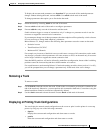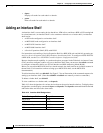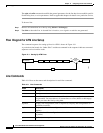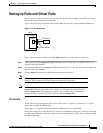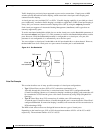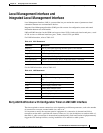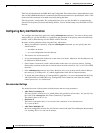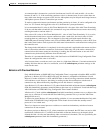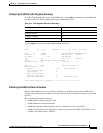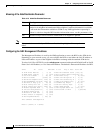
19-7
Cisco BPX 8600 Series Installation and Configuration
Release 9.3.10, Part Number 78-11603-01 Rev. D0, July 2001
Chapter 19 Configuring Circuit Lines and Ports
Local Management Interface and Integrated Local Management Interface
A connection that is derouted at a period of time between 0 and N will send out Abit = 0 at a time
between X and X + N, if the connection continues to be in a derouted state. In cases where there are
many Abit status changes to report to CPE, the last Abit updates may be delayed much longer because
Abit updates process about 47 connections per second.
To make a compromise between performance and the granularity of timers, N can be configured to be
from 3 to 255 seconds; the bigger the value of N, the better the system performance.
It is recommended that X (value of Abit Timer Multiplier M * the value of the Abit Timer Granularity
N) be set such that when a trunk fails, the connections are given sufficient time to reroute successfully,
avoiding the need to send out Abit = 0.
If the value of X (value of Abit Timer Multiplier M * value of Abit Timer Granularity N) is set to be
smaller than the normal time to reroute connections when a trunk fails, the time it takes to finish
rerouting them may take longer. This can happen for line cards and feeder trunks that have the
LMI/ILMI protocol running on those cards, such as BXM on BPX and Frame Relay cards on IGX. Note
that it takes time for those cards to process the Abit status information for each connection coming from
the controller card.
The change in the Abit behavior is completely local to the node and is applicable to the master and slave
ends of connections when the connections are derouted. When only one of the nodes connected by a
connection has this feature turned on, the timing in sending the Abit notification at one end of the
connection may be drastically different from the other end.
Therefore it is recommended that the Early Abit Notification on ILMI/LMI Using Configurable Timer
feature be configured the same on all nodes.
Also, because timers on nodes are not in sync, there is a slight time difference (3 seconds maximum) in
sending Abit from the two ends of a connection, even if the cnfnodeparm parameter settings on the
nodes are the same.
Behavior with Previous Releases
Early Abit Notification on ILMI/LMI Using Configurable Timer is supported on both the BPX and IGX
platforms. A Release 9.2 IGX or BPX node using this feature is compatible with Release 8.4 and
Release 8.5 nodes or Release 9.1 IGX and BPX nodes so that all existing connection related functions
will continue to work. However, the timing in sending out the Abit notifications at both ends of
connections may behave differently, depending on how this feature is configured.
A pre-Release 9.1.07 node or Release 9.1.07 node withtheSend Abit on Deroute feature (cnfnodeparm
Send Abit immediately parameter) turned off behaves the same way as a Release 9.2 node with the Early
Abit Notification on ILMI/LMI Using Configurable Timer feature disabled.
A Release 9.1.07 node with the cnfnodeparm Send Abit immediately parameter set to yes behaves the
same way as a Release 9.2 node with the Send Abit Early parameter set to yes and the Abit Timer
Multiplier M set to 0.
To follow the general Release 9.2 interoperability guideline, it is not recommended that the Early Abit
Notification on ILMI/LMI Using Configurable Timer feature be used when the standby control
processor is in a locked state.
There is no impact on control processor switchover or trunk card redundancy switchover because
connections are not rerouted.
In releases previous to Release 9.1.07, when connections are derouted, the CPE does not receive Abit
notifications. In Release 9.1.07 on BPX, the Send Abit on Deroute feature was developed, which
allowed the Abit = 0 to be sent immediately when a connection is derouted. (This was specified by the
cnfnodeparm parameter Send Abit immediately parameter.)



